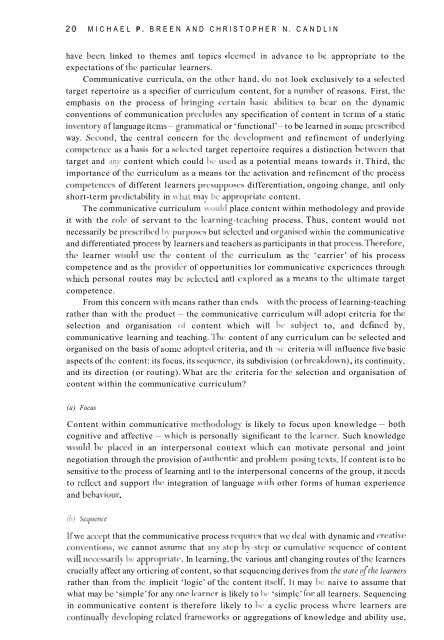Download - Search
Download - Search
Download - Search
Create successful ePaper yourself
Turn your PDF publications into a flip-book with our unique Google optimized e-Paper software.
20 MICHAEL P. BREEN AND CHRISTOPHER N. CANDLINhave been linked to themes antl topics tlccmctl in advance to lie appropriate to theexpectations of the particular learners.Communicative curricula, on the other hand, do not look exclusively to a selectcdtarget repertoire as a specifier of curriculum content, for a number of reasons. First, theemphasis on the process of Iiringing ccrtain basic abilitics to bear on the dynamicconventions of communication prccludcs any specification of content in terms of a staticinvcntory of language items grammatical or ‘functional’ ~ to be learned in some prescribedway. Sccond, the central concern for the development and refincmcnt of underlyingcompctcncc as a basis for a sclcctcd target repertoire requires a distinction bctwccn thattarget and an)’ content which could be used as a potential means towards it. Third, theimportance of the curriculum as a means tor the activation and refincmcnt of the processcompetcnccs of different learners IiresupIioses differentiation, ongoing change, antl onlyshort-term prcdictability in \\.hat may lie appropriatc contcnt.The communicative curriculum \vould place contcnt within methodology and provideit with the role of servant to the Icarning-tcaching process. Thus, content would notnecessarily be prescrihcd by purposes but selected and organisctl within the communicativeand differentiated prucess by learners and teachers as participants in that process.Therefore,the learner would usc the content 01’ the curriculum as the ‘carrier’ of his processcompetence and as the provider of opportunities lor communicativc cxpcricnces through\vhich personal routes may lie sclcctcd antl explored as a means to the ultimate targetcompetence.From this concern with mcans rather than ends mith the process of learning-teachingrather than with the product ~ the communicative curriculum will adopt critcria for theselection and organisation 01’ content which will be suliject to, and defined by,communicative learning and teaching. ’l’hc content of any curriculum can lie selected andorganised on the basis of some adolited criteria, and th criteria will influence five basicaspects of thc content: its focus, its scqucncc, its subdivision (or hrcakdo\vn), its continuity,and its direction (or routing). What arc the critcria for the selection and organisation ofcontent within the communicative curriculum?(a) FocusContent within communicative mcthotlology is likely to focus upon knowledge ~ bothcognitive and affective ~ \vhich is personally significant to the Icarncr. Such knowledgen-ould 1)c placcd in an interpersonal context hvhich can motivate personal and jointnegotiation through the provision of authcntic and ~irolilcm-posing tcxts. If content is to bcsensitive to thc process of learning antl to the interpersonal concerns of the group, it needsto reflect and support the integration of language hvith other forms of human experienceand hehaviour.(/I,Scy1renceIf \vc accept that the communicative process requires that \vc deal with dynamic and creativcconvcntions, \vc cannot assume that any stcii-by-stcp or cumulativc sequcnce of content\vi11 ncccssarily be appropriatc. In learning, the various antl changing routes of the lcarncrscrucially affect any orticring of content, so that scqucncing derives from the state frhe learnersrather than from the implicit ‘logic’ of the content itsclf. It may be naive to assume thatwhat may he ‘simple’ for any one learner is likely to be ‘simplc’ for all learners. Sequencingin communicative content is therefore likely to be a cyclic process where learners arecontinuall? developing related lrameworks or aggregations of knowledge and ability use,


